Brewster Buffalos
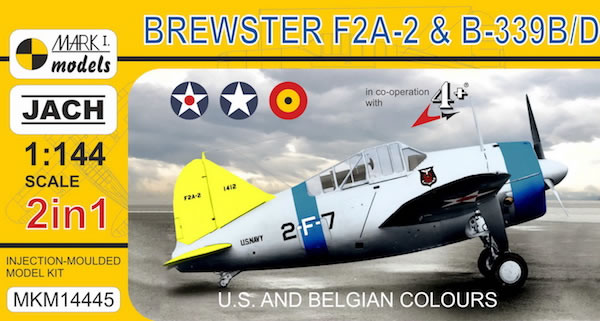
Mark 1 Models, 1/144 scale
S u m m a r y : |
Catalogue Number: |
MKM14444 – Brewster F2A-1 & B-239
MKM14445 – Brewster F2A-2 & B-339B/D
MKM14436 – Brewster Buffalo Mk.I & B-339D |
Scale: |
1/144 |
Contents & Media: |
Fifty-five grey and six clear styrene parts per kit; plus waterslide decals covering four aircraft with each boxing. |
Price: |
Available online from: |
Stockist |
F2A-1 &
B-239 |
F2A-2 &
B-339B/D |
Buffalo Mk.I
& B-339D |
Hannants |
£11.66 |
£11.66 |
£11.66 |
Modelimex |
€12.81 |
€12.81 |
€12.81 |
Hobby Link Japan |
¥2,250 |
¥2,250 |
¥2,250 |
Click here for currency conversion. |
Review Type: |
First Look. |
Advantages: |
Readily available, good scale finesse. |
Disadvantages: |
Some small details absent (but easily scratch-built). |
Conclusion: |
Mark I’s Buffalo kits are very nicely executed with exquisite surface detail and general finesse; they also cater for essential differences between versions. Clear instructions, nice colour schemes, and excellent decals only reinforce the overall quality of these kits.
There are some small details missing that I feel are needed for the sake of completeness. Scratch-building these items may be fair enough and easy to do, but I think that the instructions should have mentioned them.
The above minor gripe aside, these readily available, good quality kits should be welcomed by the 1/144 scale community, and prove a popular addition to Mark I Models’ ever growing range of small-scale kits. Neatly finished, they have the potential to produce little gems that will be very undemanding on display space.
All three boxings are highly recommended. |
Reviewed by
Mark Davies

Sword's 1/72 scale scale Gannet AEW.3 is available online from
Squadron.com
The stubby Buffalo fighter, designed and built in the late 1930s by the American Brewster Aeronautical Corporation, was one of the first U.S. Navy’s monoplane aircraft destined for carrier-borne operations. It was a single-seat, all-metal mid-wing monoplane with fabric-covered control surfaces and a retractable undercarriage. Powered by a Wright R-1820 Cyclone radial engine, it was fitted with Hamilton Standard propeller and its armament consisted of two machine guns in the nose and one in each wing.
Deliveries of the first variant, the F2A-1, began in mid-1939. Only eleven aeroplanes were delivered to the Navy’s VF-3 unit aboard USS Saratoga, while 44 de-navalised aircraft were sold to Finland early in 1940 as the Model B-239. In Finnish service the Brewsters gallantly fought against the Soviet Union, becoming popular among its pilots and earned a reputation as one of the most successful fighters.
In the U.S. naval service, the Buffalo soon became obsolete and was replaced by the F4F Wildcat, whereas in Finland the last B-239s continued to fly until 1948.
The F2A-2 was the second variant, replacing the A-1 on the production line in the spring of 1940. Powered by a Wright R-1820 Cyclone radial engine, it was equipped with cuffed Curtiss Electric propeller, large spinner and four machine guns of the same calibre – two in the nose and one in each wing.
Forty-three aircraft were ordered by the Navy, while another eight F2A-1s were modified to A-2 standard. Belgium ordered 40 Brewster B-339B aircraft, a de-navalised F2A-2s with a longer tail, but in the event, none of these planes reached the destination country. The Model B-339D was originally built for the Netherlands East Indies; following its surrender a handful of aircraft were transferred to the U.S. 5th Air Force in Australia and then lent to the RAAF.
The Model B-339E, or the Buffalo Mk.I, was an export de-navalised variant of the F2A-2 for the Royal Air Force service in the Far East. With 170 aircraft built, it was inferior in performance to the original F2A-2 model having a less powerful Wright R-1820 Cyclone radial engine and being heavier due to additional equipment. It was fitted with Hamilton Standard propeller with a large spinner and a fixed tail wheel. Its armament consisted of two machine guns in the nose and one in each wing.
The first Buffalo Mk.Is arrived in Singapore in the spring of 1941, where they also equipped a few RAAF and RNZAF squadrons. In the Burma/Malaya theatre the Buffalos bravely fought against the Japanese, but were soon outclassed by the Zero fighters. When the Commonwealth units withdrew to the islands of the Netherlands East Indies, a handful of Buffalo Mk.Is were turned over to Dutch squadrons. In 1942, some ex-Dutch aircraft were captured and tested by Japan.
Source: Mark I Ltd
Click on this Wikipedia linkfor a more detailed account of the Buffalo’s development and operational history.
Mark I Ltd is well known for their 4+ range of aviation booklets, Mark I Guides and decal sets, the CMR range of resin kits, and the Attack Hobbies 1/144-scale range of jet aircraft. This last range was re-boxed and released with new decals, along with two ex-Eduard 1/144 kits of the Bf 109G & Fw 190A. Mark I has also released its own new tool 1/144-scale kits covering different versions of the Westland Wessex, Heinkel He 219, Focke-Wulf Ta 152H, Bristol Beaufighter, and now the Brewster Buffalo.
Previous 1/144 Buffalo Kits
The Buffalo has been offered in 1/144 scale by two Japanese companies. F-Toys issued a pre-painted simple assembly injected kit, whilst Kami de Korokoro issued a resin kit. From images I have seen of these kits they do appear quite nice, although a little simplified. Nonetheless, a more readily available mainstream injected kit that covers the major variants is sure to be welcomed by fans of this small scale.
Contents

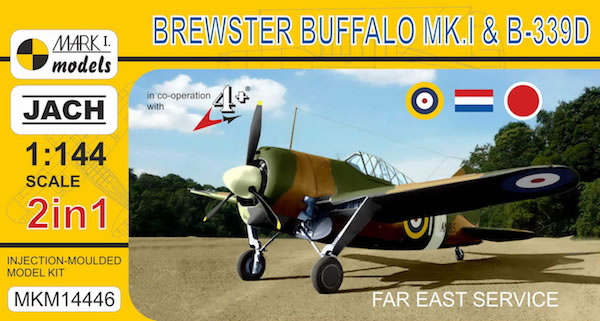
Each of the kits comes packed in a good quality end-opening box with nice artwork on the front and colour profiles on its rear. All parts are sealed in a plastic bag with the instructions and decals, and the clear parts are further enclosed in their own small bag. The instructions are formed by a fold-out sheet with colour printing. They include a parts map and clear assembly diagrams that are easy to follow. All text is in English, with detail colour call-outs included.
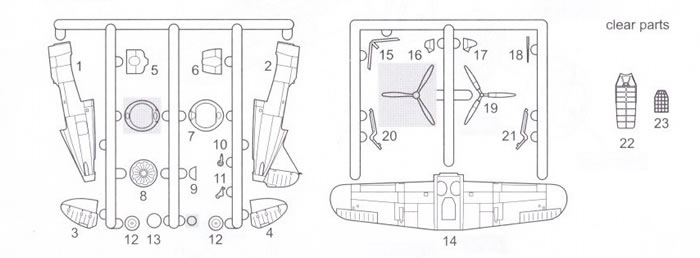
The instructions include a four-view coloured painting & markings guide for each option, with generic names used for the main airframe colours.
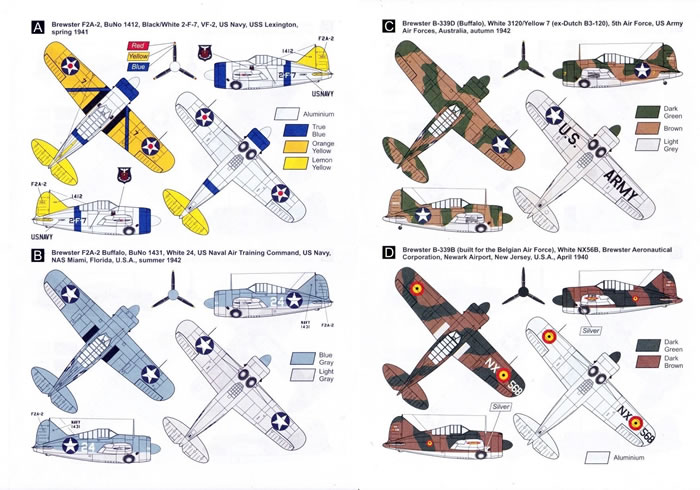
The Kits
Each kit has the same styrene components sufficient for two models to be completed, but obviously have different decals and suitable variations in the instructions and colour & markings guides for the version concerned. I received two of the three boxings as review samples, these being the F2A-2 & B-339B/D and Buffalo Mk.I & B-339D.
I shall generally refer to all versions as Buffalo, and use other more specific nomenclature when warranted.
All parts are very crisply moulded, with delicate surface detail that is superb for the scale. Other detail parts are as fine as can reasonably be expected. The kit follows a conventional breakdown for this type of aircraft. The wings are one piece, the fuselage has an undercarriage bulkhead to prevent see-through into the cockpit. The W-configuration main landing gear and wheels look good and include wheel well detail; whilst the engine, cowl, propeller and spinner are all separate parts. I shall cover off the different parts dealing with model variations later.
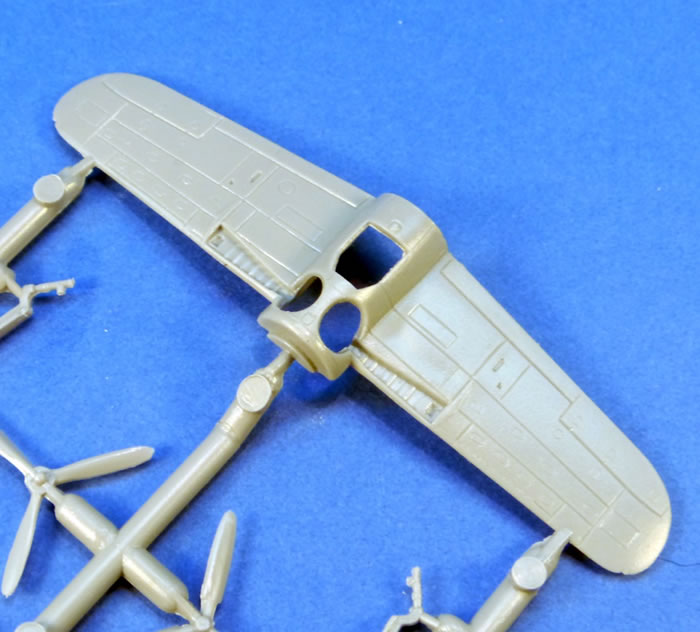
The simplified cockpit is formed from combined seat and bulkhead, a separate instrument panel and integral sidewall detail. No doubt Brengun will issue a PE detail set for ‘sick puppies’ who wish to really go to town in this tiny scale! The canopy and floor window are clear and thin enough, but not much will be visible inside with all that framing.

There is tiny difference between the F2A-1 and F2A-2 in the shape of rearmost two panels of the ventral window; understandably, Mark I has not bothered with this given the scale. Some land-based Buffalos had the ventral window over-painted, or in some cases, it seems, they were removed and smooth-panelled over. The kit’s colour & markings guides can be a little unclear on this point, as the ventral window is shown on all schemes in the under surface colour. So check references to get this right for the version and markings being modelled.
Some will want to add scratch-build the roll-over frame applicable to all versions, a telescopic gun-sight and life-raft container applicable to US variants, and head armour where applicable (although British Commonwealth Buffalos sometimes had armour removed along with other measures like partial fuel loads to reduce weight and improve their sluggish performance).
The kit caters for the different cowl between the F2A-1 & B-239 and the F2-A2 and other later models. Understandably, the five-inch difference in length between the F2A-1 and F2A-2’s is not allowed for, being only 0.03” in 1/144 scale (the reduction in length was ahead of the wings to maintain centre of gravity with the change of engine).
The two cowl styles also had different exhaust pipe locations, which are not included with the kit. The stub pipes can be easily scratch-built and located as appropriate however. The differences in gas vents behind the cowl are barely noticeable in this scale without magnifiaction, but the pattern moulded in the fuselage is applicable to the F2A-2 and B-339. It is easy enough for the ultra-fussy to fill in all but two either side for the earlier F2A-1 & B-239.
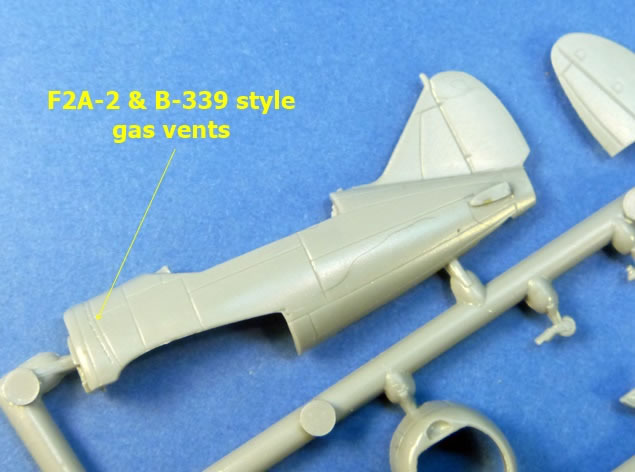
A choice of narrow and broad blade propellers is provided, along with their applicable spinners. Whilst the cuffed propeller clearly has broad blades, the cuffs are so subtle given the scale that they are barely noticeable; I suggest adding a pencil line to the painted blades to define them a bit more or perhaps a wrap of decal strip that can be painted over.
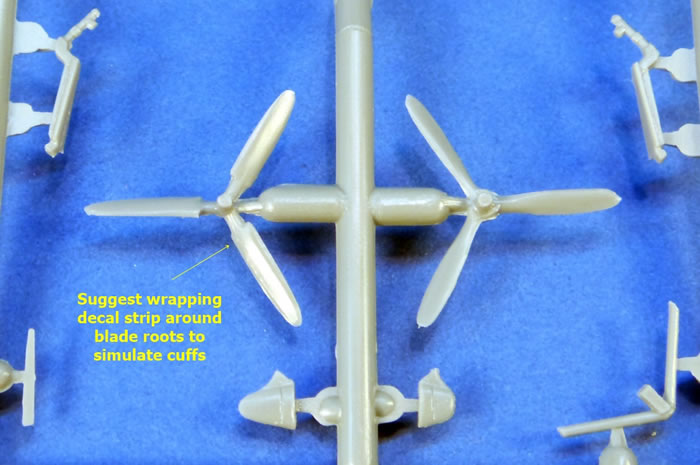
There is a choice of tail-wheel, with retractable naval style solid rear tyre, or fixed pneumatic land-based type. Land-based B-239 and B-339B’s used canvas-cuffed naval style tail wheels, so some may be fussy enough to add a dab off putty to the naval tail-wheel to represent the cuff.
Another significant visual difference between naval and land-based options is a slight difference in tail-cone shape attributable to the retractable tail-hook or lack thereof. The kit caters for both.
The instructions for the F2A-2 & B-33B/D boxing show the antenna mast as being optional, although all marking options with this boxing require it fitted. However, US Marine Squadron VF-3 did remove the mast from its F2A-2’s to reduce drag, and attached the antenna wire to a stub on the port wing.
The colour & markings guides for all kits also show a pitot in place on the starboard wing, although none is included or referred to in the assembly instructions. Obviously, in this scale such a fine item must be scratch-built (check references for style differences between versions). Finally, the skilled may wish to drill gun-holes in the wing leading edges, the less skilled can apply black dots.
I have covered at some length parts that can be scratch-built or modified for more authenticity. Given the scale, the only missing parts I think that Mark I could reasonably be expected to have included are the telescopic gun-sight, life-raft container and exhaust stubs; yet these are all details that are extremely simple to scratch up in a few minutes. So whilst little harm is done by their absence, I think their mention in the instructions is warranted; although, like the pitots, the colour & markings guides do illustrate the exhaust stubs.
Mark I have not announced an F2A-3 option, but converting the F2A-2 to one should be easy enough. Lengthen the fuselage a scale ten inches over the F2A-2 with a 0.07” plastic-card disc, use the F2A-2 cowl and its cuffed prop without the spinner after adding a short length of sprue to the prop-hub, and carefully remove the heavy framing from the canopy’s sliding hood.
Colours and Markings
MKM14444 – Brewster F2A-1 & B-239:
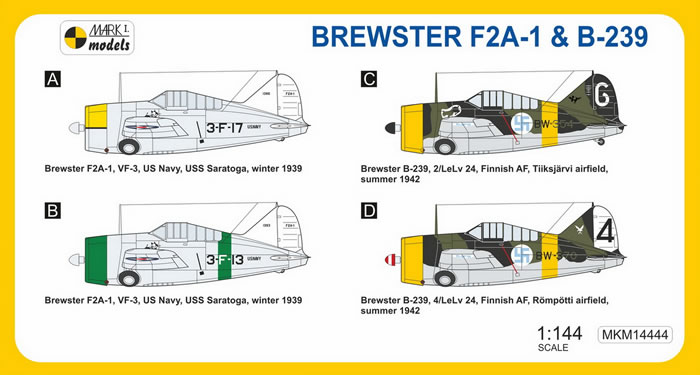
MKM14445 – Brewster F2A-2 & B-339B/D:
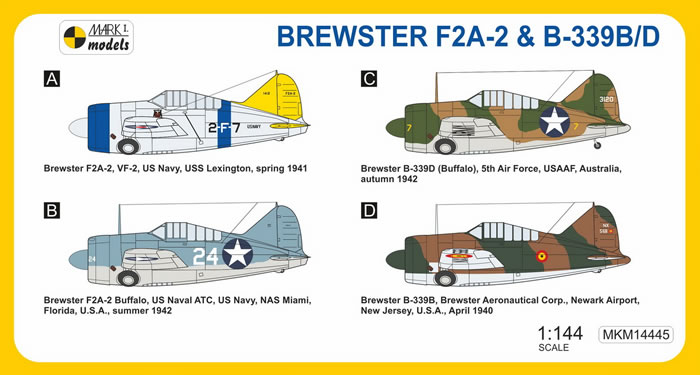
MKM14436 – Brewster Buffalo Mk.I & B-339D:
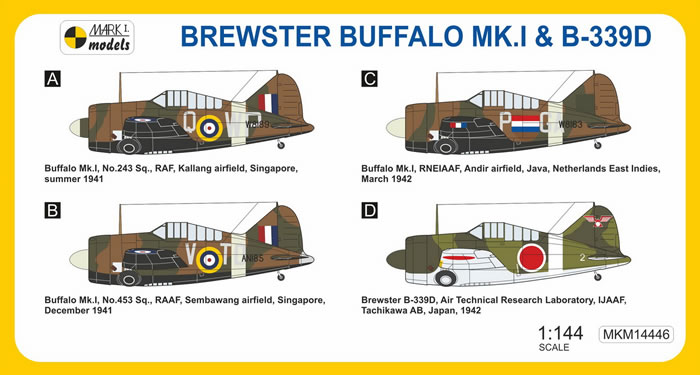
The decals appear to be excellent, as we would expect given the company's background in decal production. Whilst I did not have the decals from MKM14444, the F2A-1 &B-239 boxing, I have every reason to expect that they will be of equal quality to the two examples I did have.
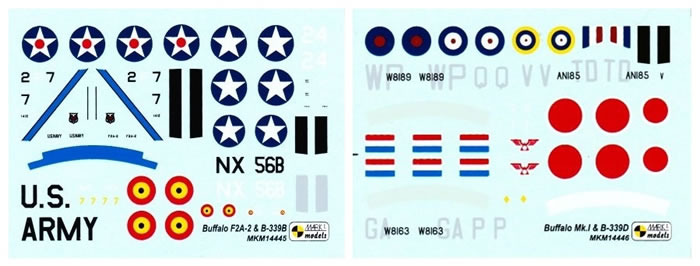
Mark I’s Buffalo kits are very nicely executed with exquisite surface detail and general finesse; they also cater for essential differences between versions. Clear instructions, nice colour schemes, and excellent decals only reinforce the overall quality of these kits.
There are some small details missing that I feel are needed for the sake of completeness. Scratch-building these items may be fair enough and easy to do, but I think that the instructions should have mentioned them.
The above minor gripe aside, these readily available, good quality kits should be welcomed by the 1/144 scale community, and prove a popular addition to Mark I Models’ ever growing range of small-scale kits. Neatly finished, they have the potential to produce little gems that will be very undemanding on display space.
All three boxings are highly recommended.
Thanks to Mark I Ltd for the review sample.
Review Text & Blue Background Images Copyright © 2016 by Mark Davies
Page Created 21 March, 2016
Last updated
21 March, 2016
Back to HyperScale Main Page

|
